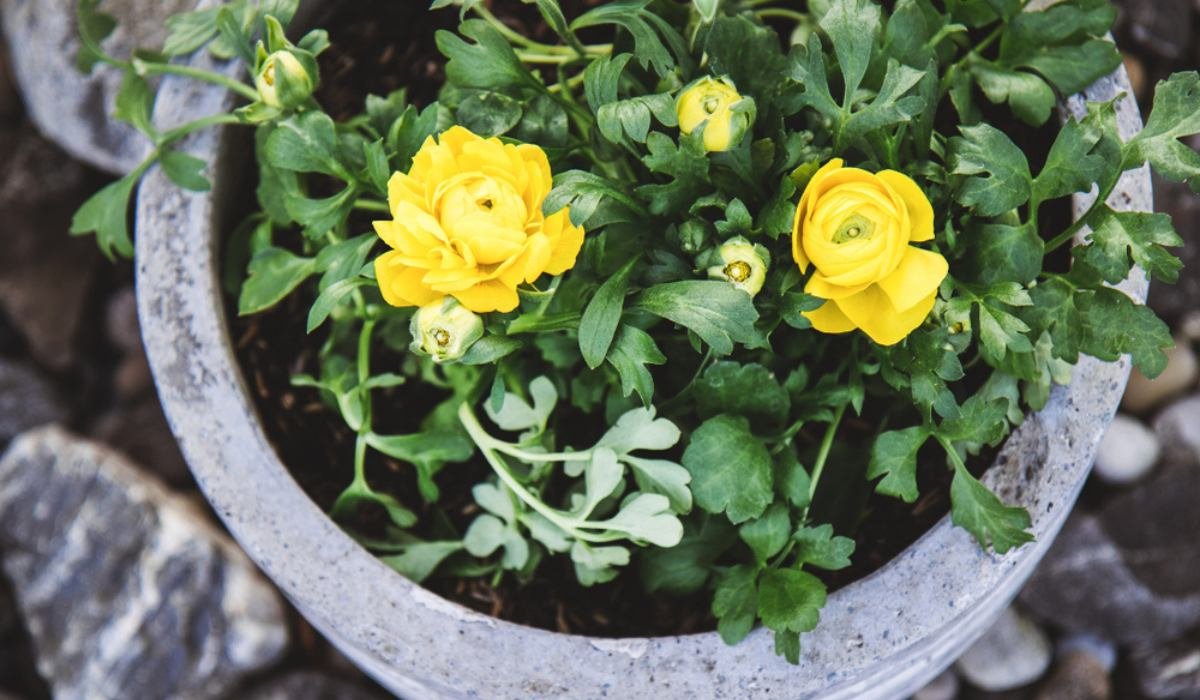The ranunculus plant, also known as the buttercup, can be a captivating addition to any garden. With its cheerful blooms in various colours, from sunny yellows and fiery oranges to delicate pinks and soft whites, ranunculus brings elegance to any landscape. Whether adorning borders and flower beds, cascading from containers, or decorating vases with cut flowers, ranunculus is a versatile plant to cultivate. Ranunculus plants are surprisingly easy to care for. They thrive in well-draining soil and need regular watering, especially during dry periods. With some attention and care, these charming flowers will flourish, adding a touch of beauty to your garden from spring to fall.
See also: How to grow desert plants at home?
Key Facts about Ranunculus
| Botanical name | Ranunculus spp. |
| Common name(s) | Buttercup |
| Family | Ranunculaceae |
| Habitat | Meadows, grasslands, woodlands |
| Plant type | Herbaceous Perennial |
| Mature size | 6-24 inch tall |
| Sun exposure | Full sun to partial shade |
| Toxic | Yes |
| Traditional Uses | Traditional medicine, ornamental |
Botanical Characteristics and Classification
Ranunculus plants are a diverse group of over 600 species in many parts of the world. They are typically herbaceous perennials, meaning they live for over two years and have non-woody stems. Ranunculus plants grow best in well-drained soil and full sun to partial shade. Ranunculus plants have been used in traditional medicine for centuries. They have been used to treat various ailments, including skin problems, stomach upset and respiratory problems. Ranunculus plants are also popular ornamental plants, often grown in gardens and as cut flowers.
Toxicity in Ranunculus plants
Ranunculus plants contain toxic compounds which can cause irritation or mild poisoning if ingested by humans or animals. The toxins present in Ranunculus plants may lead to symptoms such as skin irritation, mouth pain, vomiting and diarrhoea. It is advisable to handle these plants with caution, especially if you have pets or small children around, to avoid accidental ingestion or contact
Types of Ranunculus Plants
Each variety of Ranunculus plants brings unique charm and appeal, offering a diverse palette of colours, textures and growth habits. Here are some of the most common types:
Persian Buttercup (Ranunculus asiaticus)
The most popular in the ranunculus family, the Persian buttercup reigns supreme with its large, showy blooms in a breathtaking array of colours, from fiery oranges and sunny yellows to delicate pinks and soft whites.
French Buttercup (Ranunculus aconitifolius)
Also known as the monkshood buttercup, this variety exudes elegance and sophistication. Its tall, graceful stems are adorned with delicate, deeply cut leaves resembling monkshood’s foliage.
Globeflower (Ranunculus acritus)
Globeflower is distinguished by its spherical blooms resembling miniature globes. It has vibrant yellow leaves that are deeply cut and about one inch in diameter.
Water Crowfoot (Ranunculus aquatilis)
Water Crowfoot is an aquatic plant with pristine white flowers and glossy, submerged foliage. Ideal for ponds, streams and water features, it transforms tranquil water gardens into a haven.
Goldilocks Buttercup (Ranunculus auricomus)
Named for its golden flowers, Goldilocks Buttercup is a bright woodland plant. Its delicate blooms, reminiscent of fairy lights, add a touch of enchantment to shady meadows and forest edges. The heart-shaped leaves with a soft, fuzzy texture, complement the flowers beautifully.
These five varieties represent the diversity of ranunculus plants. Each variety has its unique charm and appeal, catering to gardeners’ diverse tastes and preferences worldwide. Whether you seek opulent blooms for borders and flower beds, delicate wildflowers for meadows and naturalised areas or aquatic gems for water gardens, a ranunculus plant is an ideal for outdoor spaces.
Caring for Ranunculus
Watering
Ranunculus plants thrive in moist, well-draining soil. Water regularly, especially during dry periods, to maintain consistent soil moisture. Avoid overwatering, as soggy soil can lead to root rot.
Fertilising
Provide ranunculus plants with a balanced fertiliser throughout the growing season for optimal growth and flowering. Apply a slow-release fertiliser or liquid fertiliser diluted to half strength every two to four weeks.
Mulching
Mulching around ranunculus plants offers a multitude of benefits. A layer of organic mulch, such as shredded leaves or bark, helps retain moisture, suppress weeds, and regulate soil temperature.
Pest and disease control
Monitor ranunculus plants regularly for signs of pests or diseases. Common pests include aphids, which can be controlled with insecticidal soap or neem oil. Fungal diseases like root rot can be prevented by maintaining good air circulation and avoiding overwatering.
Winterising
In colder climates, ranunculus plants require winter protection to survive the harsh winter conditions. In areas with mild winters, a thick layer of mulch around the base of the plants may suffice. Consider digging up the corms in harsher climates and storing them in a cool, dry place over the winter before replanting them in spring.
Additional care tips
- Deadhead blooms regularly encourage continuous flowering and prevent seed formation, which can divert energy away from flower production.
- Divide crowded clumps of ranunculus plants in the fall or spring to maintain vigour and prevent overcrowding.
- Stake taller varieties of ranunculus plants to provide support and prevent them from toppling over.
Using Ranunculus in the garden
Ranunculus plants’ versatility allows them to be incorporated into various garden settings, from borders and flower beds to containers and cut flowers.
Borders and flower beds
Ranunculus splashes of colour and delicate charm to borders and flower beds. Pair them with complementary flowers in similar shades or contrasting colours to create a harmonious and visually appealing arrangement. Combine ranunculus with lavender, sweet peas and daisies for a cottage garden style. Consider pairing them with roses, peonie, and lilies for a more formal garden aesthetic.
Containers and cut flowers
Ranunculus is a showstopper in containers, adding a touch of elegance and colour to patios, decks and porches. Choose a container that complements the size and colour of the ranunculus plants. Use terracotta pots for a rustic look; opt for glazed ceramics for a modern look. To extend the vase life of cut ranunculus, place them in a fantastic, well-lit location and change the water regularly.
Pairing Ranunculus with other plants
Ranunculus can be paired with various other plants to create stunning garden combinations. Here are some ideas for complementary pairings:
- For sunny locations: Combine ranunculus with sunflowers, zinnias and coreopsis for a cheerful and vibrant display.
- For partial shade: Pair ranunculus with hostas, ferns, and astilbe for a harmonious blend of textures and colours.
- For water gardens: Surround ranunculus with water lilies, lilies, and irises for a serene and enchanting aquatic oasis.
Creating stunning spring or fall displays
Ranunculus is a versatile plant that can create stunning spring or fall displays. In spring, plant ranunculus corms in well-draining soil and enjoy a burst of colour in your garden. In fall, plant ranunculus corms indoors and enjoy their blooms in winter.
FAQs
How to grow ranunculus in India?
Growing ranunculus in India requires careful consideration of the climate and soil conditions. Choose a planting location that receives ample sunlight but avoid extreme heat. Plant the corms in well-draining soil during the cooler months, typically between October and November. Water regularly to ensure the soil remains moist but not soggy. Fertilise every four to six weeks to support growth and flowering. Protect the plants from frost if necessary.
Is ranunculus a rose?
No, ranunculus is not a rose. Ranunculus belongs to the Ranunculaceae family, while roses belong to the Rosaceae family. Both ranunculus and roses are popular flowering plants with distinct characteristics and classifications.
What is a ranunculus flower called?
Ranunculus flowers are commonly known as buttercups. The name ranunculus derives from the Latin word rana meaning frog, possibly alluding to their preference for moist habitats.
What is the symbolism of ranunculus?
Ranunculus symbolises charm, cheerfulness and new beginnings. In some cultures, it represents grace, purity and innocence. The different ranunculus colours carry specific meanings: red symbolises passion and love, yellow signifies joy and friendship, white represents purity and innocence and pink embodies gratitude and appreciation.
How to care for ranunculus?
Ranunculus are relatively low-maintenance flowers. They should be watered regularly but one should avoid overwatering. The soil should be kept moist but not soggy. Deadhead spent flowers to encourage more blooms. Ranunculus are susceptible to aphids, so be sure to check your plants regularly and treat them with insecticidal soap if necessary.
What are ranunculus corms?
Ranunculus corms are small, bulb-like structures that store food and energy for the plant. They are typically brown in colour and have a pointed end. Ranunculus corms are planted in the fall or spring and will bloom in the spring or early summer.
Where can I buy ranunculus corms?
Ranunculus corms can be purchased from online retailers and garden centres. They are typically available in the fall.
How to make ranunculus last longer?
Ranunculus will last for about five to seven days in a vase. To extend their life, cut the stems fresh and place them in a vase with clean water. Change the water every few days and keep the vase in a cool place, away from direct sunlight.
| Got any questions or point of view on our article? We would love to hear from you. Write to our Editor-in-Chief Jhumur Ghosh at jhumur.ghosh1@housing.com |
Saswat Kumar, a real estate writer, keeps up with the latest trends in residential real estate. He simplifies complex real estate jargon, making it accessible to all. Saswat’s data-driven analysis empowers buyers and investors to make informed choices in the housing market.












